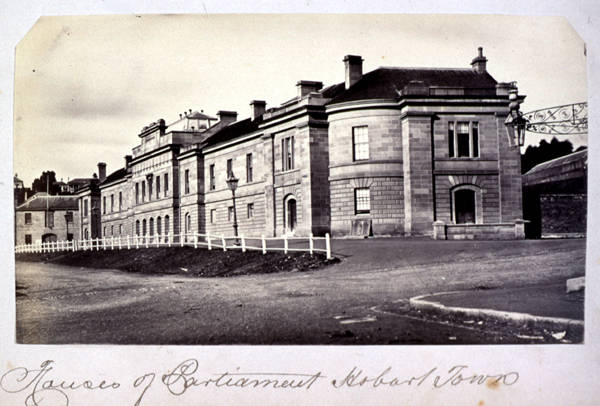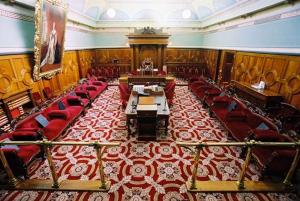 |
 |
|
Legislative Council
In 1825, Governor Darling of New South Wales proclaimed Van Diemen’s Land as a separate colony. Simultaneously the first Legislative Council was created, consisting of the lieutenant-governor, George Arthur, and six nominee members. Council membership increased in 1828 to 15 nominee members (six official and eight unofficial) with the governor as presiding officer. In 1851, Legislative Council membership was further increased to a total of 24 members, 16 elected by restricted franchise and 8 nominated by the governor, who ceased to be a member. From 1841 to 1856 the Legislative Council met in the Long Room which became the House of Assembly Chamber (1856–1940) and is now the Members’ Lounge. In 1856 the Council moved into the present Chamber. This is highly ornate and dominated by a high ceiling and clerestory. The members’ benches consist of two rows of red couches that face each other across the Chamber. Since the establishment of a bicameral Parliament in 1856, the size of the Legislative Council has varied as follows (year – numbers): 1856–15; 1870–16; 1885–18; 1898–19; 1900–18; 1946–19; 1998–15. Full adult suffrage was introduced in 1968. The Legislative Council is the upper house of the Tasmanian Parliament and in 2004 has fifteen members, from single-member electorates. Members serve six years with two or three members elected in May each year. Historically the Legislative Council has had a majority of members unaligned to political parties. Some commentators consider the Legislative Council to be conservative in its views on reforming legislation. When incorporated as part of the bicameral parliament in 1856, the Legislative Council had 15 members, one third of whom were to go to election every three years. In 1859 a fixed six-year term for each member of the Legislative Council was introduced, prompted in part by a series of deliberate resignations that muddled the election pattern. The Tasmanian constitution does not allow the state governor to dissolve the Legislative Council. The Council therefore never faces the voters together, even as a 'half’ election as in other Australian states. This is designed to make it a continuing body acting as an independent house of review.
The Council uses a version of the single-transferable vote method of election. This system, also used for the Federal House of Representatives, is a preferential voting method known as the 'alternative vote’. By this method voters express their preferences. Candidates are elected if they gain 50 percent of the vote plus one (an absolute majority). If no candidate achieves such a majority, the lowest is excluded and that candidate’s second preferences are distributed as full votes (ie a value of one). This recurs until one of the remaining candidates gains the required absolute majority. Casual vacancies as a result of death or resignation result in by-elections for the remaining term for that seat. Further reading: www.parliament.tas.gov.au/tpl/backg/BackGrounders.htm; Parliamentary Library, 'Backgrounder’ information sheets, 2002. Bryan Stait
|
Copyright 2006, Centre for Tasmanian Historical Studies |

